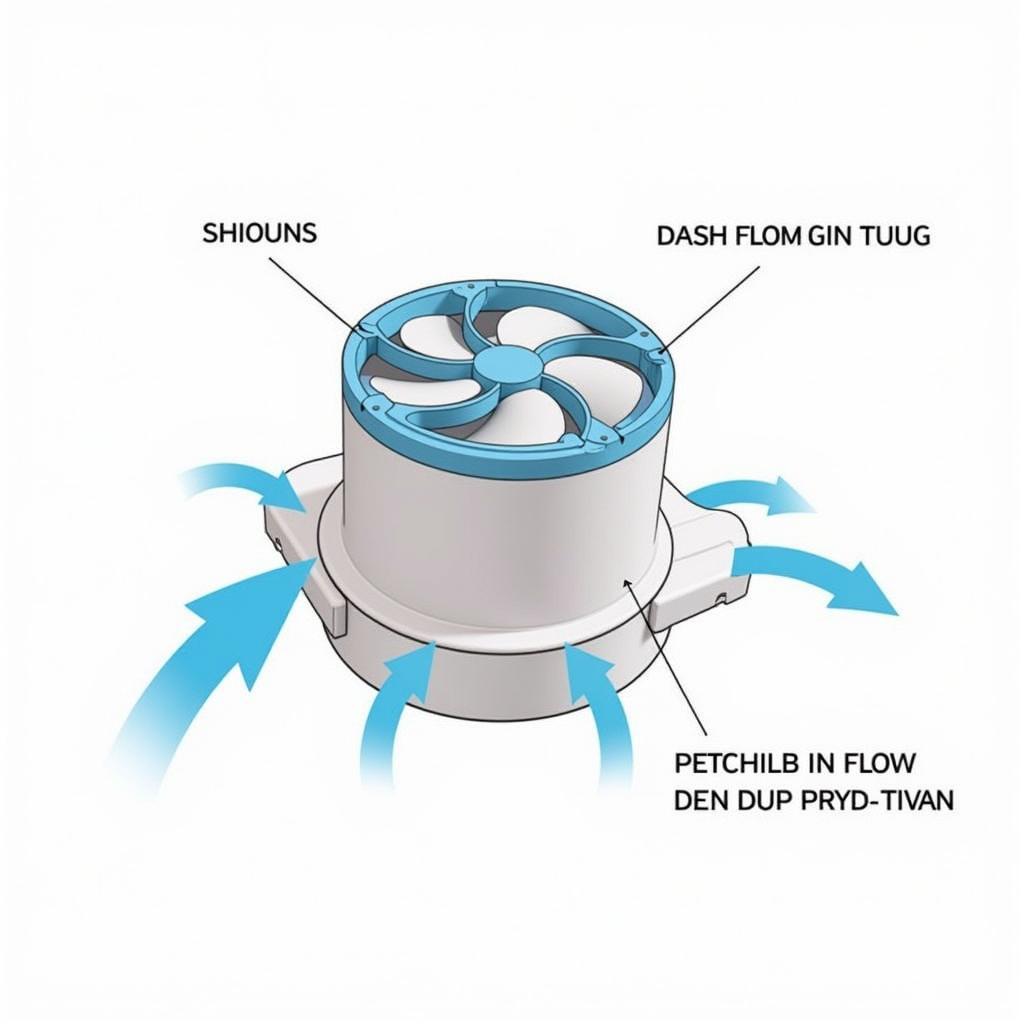A Fan Duct Cooling Shroud might not be the most glamorous component of a cooling system, but its role is crucial in maximizing cooling efficiency. This often-overlooked component plays a vital role in directing airflow and improving the performance of fans, especially in demanding applications like high-performance computing and industrial settings.
How a Fan Duct Cooling Shroud Works
 Diagram of a fan duct cooling shroud
Diagram of a fan duct cooling shroud
Essentially, a fan duct cooling shroud acts like a tunnel for the air being moved by a fan. Instead of allowing the fan to disperse air in a wider, less controlled pattern, the shroud captures and channels the airflow in a specific direction. This targeted approach minimizes pressure loss and ensures that heat is dissipated efficiently from the heat source, whether it’s a CPU heatsink, a graphics card, or industrial equipment.
Benefits of Using a Fan Duct Cooling Shroud
The benefits of incorporating a fan duct cooling shroud into your cooling setup are numerous:
- Improved Cooling Efficiency: By directing airflow precisely where it’s needed, shrouds minimize wasted airflow and maximize heat dissipation. This translates to lower operating temperatures for your components.
- Reduced Noise Levels: A shroud can help reduce noise generated by the fan in two ways. First, it can minimize turbulent airflow, which contributes to noise. Second, it allows the fan to operate at lower speeds while maintaining the same cooling performance, further reducing noise output.
- Increased Lifespan of Components: Lower operating temperatures directly correlate to a longer lifespan for your components. By preventing overheating, a shroud contributes to the longevity of your hardware.
Applications of Fan Duct Cooling Shrouds
While often associated with computer cooling, fan duct cooling shrouds find applications in a wide range of fields:
- Computer Systems: Shrouds are commonly used to cool CPUs, GPUs, and power supplies, ensuring stable performance even under heavy workloads.
- Industrial Equipment: In industrial settings, shrouds are crucial for cooling machinery, motors, and other components, preventing overheating and costly downtime.
- Automotive Applications: Shrouds are used in vehicle cooling systems to improve the efficiency of radiators and engine cooling fans.
Choosing the Right Fan Duct Cooling Shroud
Selecting the appropriate fan duct cooling shroud depends on various factors:
- Size and Compatibility: Ensure the shroud’s dimensions are compatible with your fan and the available space within your setup.
- Material: Shrouds are typically made from materials like plastic, acrylic, or metal. Consider factors like durability, heat resistance, and aesthetics when making your choice.
- Design: Shroud designs vary, and some may offer features like adjustable airflow direction or integrated dust filters. Choose a design that aligns with your specific needs.
Conclusion
Investing in a fan duct cooling shroud is a wise decision for anyone looking to optimize their cooling setup. By improving cooling efficiency, reducing noise, and extending component lifespan, a shroud offers significant benefits that outweigh its often-minimal cost. Whether you’re a PC enthusiast, an industrial operator, or anyone concerned about effective cooling, don’t underestimate the impact of this small but mighty component.
FAQs
1. Can I use a fan duct cooling shroud with any type of fan?
While shrouds are compatible with most axial fans, it’s essential to choose a shroud that matches the size and specifications of your fan for optimal performance.
2. How do I install a fan duct cooling shroud?
Installation typically involves attaching the shroud to the fan using screws or clips. Consult the manufacturer’s instructions for specific guidance.
3. Can a fan duct cooling shroud completely eliminate fan noise?
While a shroud can significantly reduce fan noise, it might not eliminate it entirely. Other factors like fan quality and overall system design also contribute to noise levels.
4. What are some common materials used for fan duct cooling shrouds?
Common materials include plastic, acrylic, and metal, each offering different levels of durability, heat resistance, and aesthetics.
5. Are fan duct cooling shrouds only beneficial for high-performance systems?
No, shrouds can benefit any system where cooling is crucial, from gaming PCs to industrial equipment.
6. Can I create a DIY fan duct cooling shroud?
Yes, with some creativity and basic materials, you can create a custom shroud. However, ensure your design effectively directs airflow and doesn’t obstruct other components.
7. Where can I purchase a fan duct cooling shroud?
Shrouds are readily available from online retailers, computer hardware stores, and specialized cooling solution providers.
For more information about cooling solutions and related products, you can explore these resources:
Need help finding the right fan duct cooling shroud for your needs? Contact us! Our team is available 24/7 to assist you. Reach us at Phone Number: 0903426737, Email: fansbongda@gmail.com or visit us at Address: Lot 9, Zone 6, Gieng Day Ward, Ha Long City, Gieng Day, Ha Long, Quang Ninh, Vietnam.


